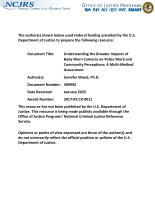Body-worn cameras
Law Enforcement Tools to Detect, Document, and Communicate Use of Service Weapons
Understanding and Reducing Deaths in Custody: Analysis of the Bureau of Justice Assistance Death in Custody Reporting Act (DCRA) Data
Understanding the Broader Impacts of Body Worn Cameras on Police Work and Community Perceptions: A Multi-Method Assessment
Measuring "What Matters" in 21st-century Policing: Partnering with Civilian Oversight to Assess Procedurally Just Policing in Philadelphia
Dialogue that Works: Examining Police Communication Strategies and Citizen Compliance
Responding to Intimate Partner Violence Related Strangulation Integrating Policy, Practice, and Rese
This webinar examines the problem of Intimate Partner Violence Strangulation and an innovative response policy. The presentation will include an overview of the nature and extent of strangulation, its dangers, and adverse medical consequences followed by a review of a Strangulation Ordinance in Burleson, Texas that mandates extensive training for first responders and a city-wide response protocol for strangulation detection and investigation, documentation of strangulation signs and symptoms, medical assistance, and service referrals for strangulation survivors.
See the YouTube Terms of Service and Google Privacy Policy
Comparing the Uses and Benefits of Stationary Cameras Versus Body-worn Cameras in a Local Jail Setting
Deploying Body-worn Cameras in a Jail Setting: Impacts and Lessons Learned
A Statewide Assessment of the Impact of Virtual Check-Ins for Community Supervision
Does Training Police Officers In Brazilian Jiu-Jitsu Improve Use Of Force Outcomes? An Experimental Evaluation With Systematic Social Observation in the Colorado Springs Police Department
Unwinding the Impact of Body Worn Camera Evidence on Prosecutor Workload
Redesigning Life in U.S. Prisons
The prison system in the U.S. typically places a heavy emphasis on security, control, and punishment, and this foundation can create an adversarial culture within correctional facilities — incarcerated individuals versus correctional staff. But what if that culture could change? What would it look like? How would it impact not only incarcerated individuals but also correctional officers and other staff?





